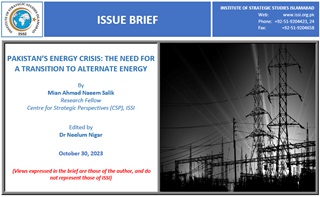Like many other developing countries, Pakistan has been grappling with a severe energy crisis for several years. The demand for energy continues to surge due to population growth, urbanization, and industrialization, while the supply of conventional energy sources remains inadequate. This energy deficit has led to frequent power outages, hampering economic growth, disrupting daily life, and impeding technological progress. In this context, the adoption of alternative energy sources presents a compelling solution to address Pakistan’s energy crisis.[1]Pakistan’s energy crisis is a long-standing and multifaceted issue that has significantly impeded the country’s economic growth and development. Pakistan witnessed acute energy crisis during the summer months from May-August 2023. The electricity shortfall widened to 7,000 megawatts with demand rising to 28,200 megawatts, while the power supply was 21,200 megawatts.[2]
Home ISSI Publications Articles Issue Briefs Issue Brief on “Pakistan’s Energy Crisis: The Need for a Transition to...















